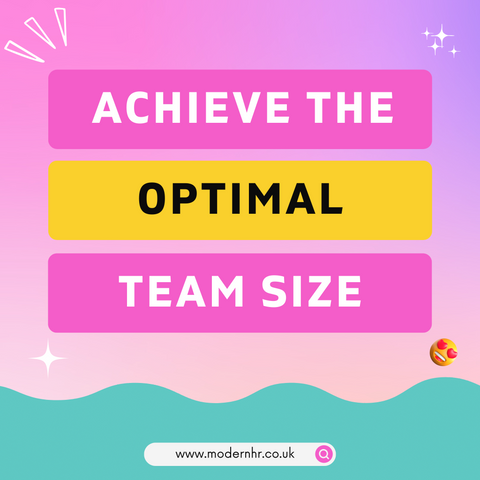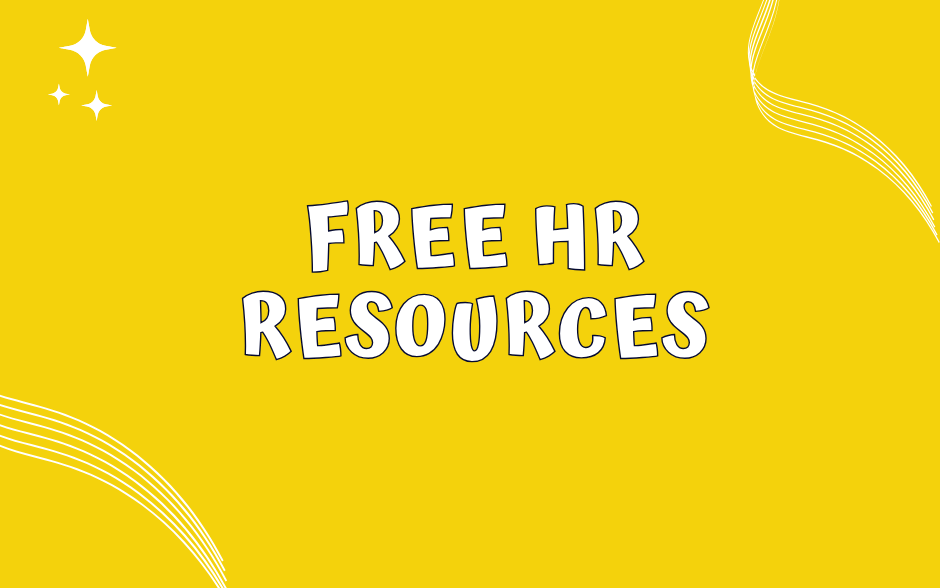How to achieve the optimal Team Size with more ease

This is one of my favourite strategic HR questions I ask my clients to help build a high performing team.
After all, there’s a direct correlation between how big and costly your team is, 👥 how big your profits are 💷 and how happy your customers and employees are. 😎
Every extra person you hire adds cost, so it's important that the investment in that extra role is able to drive up income or save time / costs for it to make commercial sense. And often you can reach a tipping point, where the average profit per employee goes down. So, it's really important that you track your team performance metrics to make the right decision about people on our teams — and specifically, the right number of people.
This leads on to the focus on today's blog: “What’s the optimal team size for Small Business?”
The Team Performance Sweet Spot
Having the right team, with the right skills, doing the right work is always the ideal sweet spot.
Hire too few people, and there may be skill gaps; hire too many people and we run the risk of a bloated payroll and processes more complex than they need to be.
So we think, there’s gotta be an ideal team size. If only we could figure it out, or at least establish a rule of thumb so that we don’t screw up.
I must fess up though, there isn’t one magic formula to answer this question, because it depends on the type of business and industry as well as the maturity of the business. 🙅 Every business – including yours – is totally different in terms of what you do, how long you’ve been trading, and what your goals for the future are.
However, as a general guide some online commentators 🗣 quote the 30% number. In other words, your staff costs shouldn’t really be more than 30% of your gross revenue.
But, I think it’s more complicated than that and depends on your industry, vision and personality.

5 Steps to decide on the Optimal Team Size
With that in mind, here are 5 steps you can take to suss out if your team is the right size and also help you to improve team performance…
1. Review the team structure and design 👌
Do you have the right team size? Is it structured in a way that enables your team members to have accountability over certain key areas?
For me, a perfectly designed organisational structure – has the right number of people, with the right skills, in the right positions, doing the right work, reporting to the right people – on a daily basis.
This is the nirvana I think all businesses need to be striving to achieve. So, against this seventh heaven ambition 👼 how does your business currently fare
Symptoms of a poorly sized organisation include things like high employee turnover rates, and extortionate staff costs as well as low employee accountability or poor performance. Essentially if your team isn't high performing and meeting your goals are targets, the team structure and design may not be right.
For example, the team size may be too big if there's duplication or conflict around who does what. This was the case for one of my clients, who ended up making one team member redundant, saving a whopping £40k each year. Whilst he was sorry to lose the individual, the team morale and performance soared as a result, as the conflict has been primarily due to two members of staff fighting over tasks, because there was so much overlap and duplication within their roles.
On the other end of the scale, if people are spread to thin or you are lacking skills or expertise to be able to achieve your goals, you may need to invest in an extra person or more, to achieve the optimal team structure.
If there's an issue relating to individual performance, for a certain team member, that's a different matter entirely.
2. Consider the customer impact ✅
Your ability to serve your customers can be a pretty good indicator of whether you’ve got the right size team or not. Don’t just think about meeting deadlines as the benchmark. Think about the quality of your customer service too.
For example, if you’re skimping by paying someone an hour to do a job that takes half a day – then the output may not satisfy your client’s requirements.
If you track NPS scores or customer satisfaction, this should give you a good indicator of how things are going. Essentially, if your NPS or Customer Satisfaction scores are low, it could be you need to invest in additional staff members to support your staff or you need to upskill staff members of customer service.
3. Look at the finances 📊
The top metrics to assess the optimal team size are: sales revenue per employee and profit per employee which you can track every month/quarter over time.
If the cost of your employees are going up and yet your sales revenue and or profit remains flat, your team may be a bit inflated.
You can also work out how much money is coming in, and how much is going out – both now and in the future. Then, try and forecast the impact your new hire will have...
📈 How many extra sales they help you to make?
📈 How many more orders will they help you to fulfil?
📈 How many more customers will you now be able to take on?
📈 How much faster will we be?
Don't just look at the salary, but ALL their expenses. From a faulty laptop, to maternity leave.
4. Observe your team's morale and wellbeing
Another totally obvious indication of whether you have the right size team, is how your existing employees are performing 📈 and feeling. 😱
As a responsible employer, you have a duty of care to your staff. If you are under-resourced they could suffer burnout, then you lose out too.
On the other hand, if they’re not being challenged enough, they might start looking for another role. For example, have you got three people doing the job, when you only need two?
You can start to observe the team dynamics, which is how the team are behaving and again something to watch over time.
Wrongly-sized teams can cause conflict in the workplace too, mainly due to people working on the same thing like the 'too many cooks' story. I’ve written a blog on how to get your team to work better together. Read it here.
5. Assess the risk levels 📬
Would your business crumble if someone left suddenly, took holiday or went off sick? If you’re on a skeleton staff structure, with no room for people to take time off, this is a sign you’re too lean. 🙄
You don’t necessarily need to hire more people permanently, but at least have a plan b or some flexible resource via contractors, to ensure you have some breathing space within your business.
What's the verdict?
Do you have the optimal team size? Or do you need to invest or shrink your teams, to be more profitable & effective?






